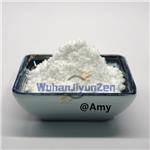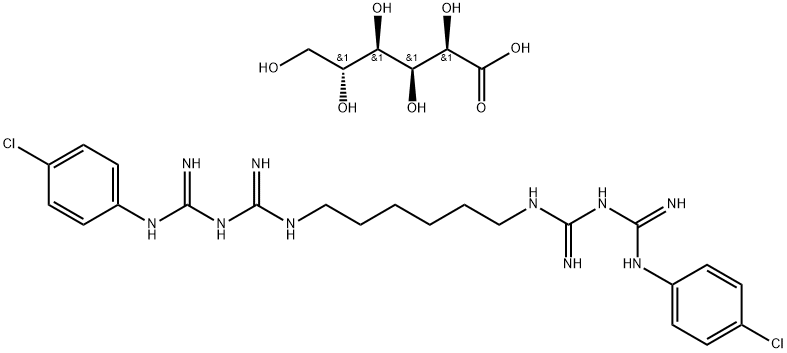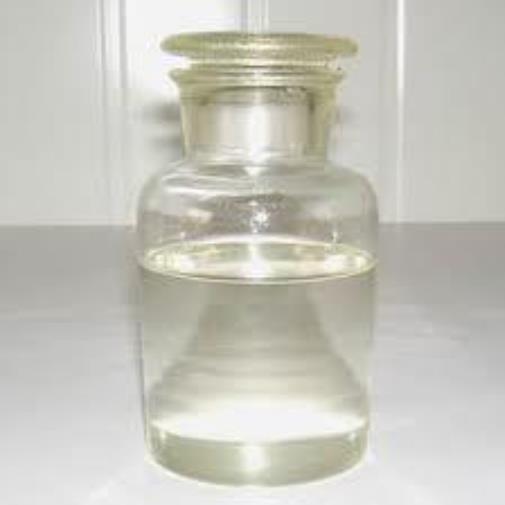General description of Chlorhexidine Gluconate
General description
Chlorhexidine Gluconate is the gluconate salt form of chlorhexidine, a biguanide compound used as an antiseptic agent with topical antibacterial activity. Chlorhexidine gluconate is positively charged and reacts with the negatively charged microbial cell surface, thereby destroying the integrity of the cell membrane. Subsequently, chlorhexidine gluconate penetrates into the cell and causes leakage of intracellular components leading to cell death. Since gram positive bacteria are more negatively charged, they are more sensitive to this agent. Chlorhexidine gluconate is an organochlorine compound and a D-gluconate adduct. It has a role as an antibacterial agent. It derives from a chlorhexidine.
Figure 1 the chemical structure of CHG
Application and Pharmacology
Chlorhexidine gluconate is chlorhexidine gluconate, the chemical name is 1,6-bis(p-chlorophenformin) n-hexane digluconate, is a cationic surfactant, has good water solubility, a certain concentration It will not cause greater irritation to the skin and mucous membranes of patients, and at the same time, it can maintain a long-term bactericidal effect when exposed to body fluids, so it has more significant disinfection performance. The mechanism is that the adsorption of chlorhexidine gluconate around the microorganism can form a physical seal, causing the denaturation and destruction of the microbial cell membrane, thereby inhibiting and killing the microbial cells. Chlorhexidine gluconate can kill all kinds of bacterial propagules, also has bacteriostatic effect at low concentration, and has accumulative activity, and has little side effect on human body. At present, the chlorhexidine gluconate disinfectant used for gynecological mucosal disinfection is generally low in concentration, and can also be widely used for skin disinfection before clinical surgery, rinsing wounds, bladder lavage, burns, neonatal skin and Umbilical cord cleaning, etc.
1.Use of chlorhexidine to eradicate oropharyngeal SARS‐CoV‐2 in COVID‐19 patients. As public distribution of vaccines against severe acute respiratory syndrome coronavirus 2 (SARS‐CoV‐2) is underway, prevention of coronavirus disease 2019 (COVID‐19) relies on minimizing spread. In this study, chlorhexidine gluconate was investigated as a topical antimicrobial agent against SARS‐CoV‐2. This was a randomized, prospective cohort study using chlorhexidine as an oral rinse and posterior oropharyngeal spray in hospitalized COVID‐19 patients. The primary outcome was presence or absence of laboratory‐confirmed SARS‐CoV‐2 in the oral and oropharyngeal cavities after 4 days of chlorhexidine use and standard of care (study group) or standard of care only (control group). SARS‐CoV‐2 was eliminated from the oropharynx in 62.1% of patients who used chlorhexidine as an oral rinse, versus 5.5% of the control group patients. Among patients who used a combination of oral rinse and oropharyngeal spray, 86.0% eliminated oropharyngeal SARS‐CoV‐2, versus 6.3% of control patients. Chlorhexidine is a simple and safe addition to current COVID‐19 prevention guidelines and may play a significant role in reducing disease Spread[1].
2. The Comparative Efficacy of Chlorhexidine Gluconate and Povidone-iodine Antiseptics for the Prevention of Infection in Clean Surgery: Alcoholic formulations of 4%–5% CHG seem to be safe and twice as effective as PVI (alcoholic or aqueous solutions) in preventing infection after clean surgery in adults. Our findings concur with the literature on contaminated and clean-contaminated surgery, and endorse guidelines world-wide which advocate the use of alcoholic CHG for preoperative skin antisepsis.[2] (CHG=Chlorhexidine Gluconate).
Synthesis
Chlorhexidine gluconate is prepared by the reaction of gluconic acid and chlorhexidine, and gluconic acid is generally prepared from gluconate. There are two main methods: one is to dissolve calcium gluconate with purified water. Filter, apply 732 type exchange resin, collect the exchange liquid, and concentrate it to the specified concentration for the production of chlorhexidine gluconate; the second is obtained by metathesis reaction of oxalic acid (sulfuric acid) and calcium gluconate[3].
Safety
The acute oral LD50 in female and male rats of the Chlorhexidine Gluconate disinfectant was higher than 5000 mg / kg.During the period of 28 days,all rats of the three exposure groups grew well and no toxic sign were observed. No significant differences in the hematological parameters and serum biochemical parameters in three exposure groups compared to the control group.The histopathological examination showed that no obvious exposure related pathological changes in all exposure rats.Under this experimental condition,the Chlorhexidine Gluconate disinfectant is actual nontoxic after an acute oral exposure.Subacute toxicity test shows no abnormality and toxic sign to SD rats[4].
Reference
1.Huang Y. H. & Huang J. T., "Use of chlorhexidine to eradicate oropharyngeal SARS‐CoV‐2 in COVID‐19 patients," Journal of Medical Virology, Vol.93, No.7(2021), pp.4370-4373.
2.Wade R. G., Burr N. E. & McCauley G. et al., "The Comparative Efficacy of Chlorhexidine Gluconate and Povidone-iodine Antiseptics for the Prevention of Infection in Clean Surgery," Annals of Surgery, Vol.274, No.6(2021), pp.e481-e488.
3.Liu Qingcui, Su Hongrui, Liu Zhongyi: "Study on the preparation process of gluconic acid solution during the synthesis of chlorhexidine gluconate", "China Pharmaceutical", No. 12, 2010, p. 53.
4.Zheng Yunyan, Yan Yan, Zhu Zhouliang, etc.: "Observation of Subacute Toxicity of Chlorhexidine Gluconate Disinfectant", "Chinese Journal of Disinfection Science", No. 06, 2022, pp. 420-422.
You may like
Related articles And Qustion
See also
Lastest Price from Chlorhexidine digluconate manufacturers

US $2.00/kg2025-06-09
- CAS:
- 18472-51-0
- Min. Order:
- 1kg
- Purity:
- 99 %
- Supply Ability:
- 10000kg

US $5.00-0.50/KG2025-05-07
- CAS:
- 18472-51-0
- Min. Order:
- 1KG
- Purity:
- 99% hplc
- Supply Ability:
- 500TONS




